Australian Navy Commissions Hobart (II) – One in a Million
Royal Australian Navy will commission the first of three new destroyers today (On 23 September). In continuing our reflective stories of previous ships that have carried the name HMAS Hobart, this is the story of Hobart (II). The second ship to bear the name Hobart was one of three Perth class guided missile destroyers built in the United States for the Royal Australian Navy. She was commissioned at the Boston Navy Yard on 18 December 1965 under the command of Captain Guy Griffiths. Following sea trials and exercises in the United States and Canadian waters, Hobart arrived in her namesake city on 1 September 1966. She berthed in her home-port of Sydney for the first time on 7 September 1966.
This Day In Naval History - July 29
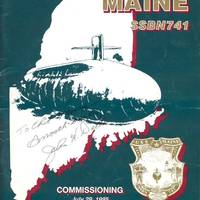
1846 - During the Mexican-American War, a detachment of Marines and Sailors, led by Arm. Col. John C. Fremont from the sloop USS Cyane, commanded by Cmdr. Samuel F. DuPont, lands and takes possession of San Diego and raises the U.S. flag. 1898 - During the Spanish-American War, the gunboat, USS Helena, commanded by Cmdr. William T. Swinburne, captures the Spanish steamer Manati at Cienfuegos, Cuba. 1920 - USS St. Louis (CA 20) is ordered to Turkish waters to protect American nationals and citizens during the Greco-Turkish War (1919-1922).
This Day In Naval History: July 14
1813 - During the War of 1812, Lt. John M. Gamble becomes the first Marine to command a ship in battle, USS Greenwich, when she captures British whaling ship Seringapatam. 1853 - Commodore Matthew C. Perry lands and holds the first meeting with the Japanese at Uraga, in which he delivers President Millard Fillmores request for a treaty to representatives to the Emperor. Allowing time for reflection and discussion, Commodore Perry returns in March 1854 and finalizes the Treaty of Kanagawa. 1944 - USS William C. Miller (DE 259) sinks Japanese submarine (RO 48) and teams with USS Gilmer (APD 11) to sink Japanese submarine (I 6). 1945 - In the first naval gunfire bombardment of the Japanese home islands, Task Unit 34.8.1 warships bombard ironworks plant at Kamaishi, Japan.
This Day In Naval History: April 25
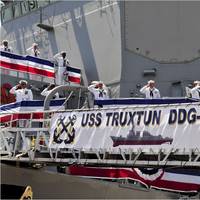
1862 - Union Flag Officer David G. Farraguts fleet sails into New Orleans, La., after long preparation and fierce battles while passing through the Confederate defenses of Fort Jackson and Fort St. Philip the previous day. 1914 - In the first use of U.S. Navy aircraft in a combat situation, Lt. j.g. P.N.L. Bellinger made a flight from USS Mississippis aviation unit at Vera Cruz, Mexico, to observe the city and make preliminary search for mines in the harbor. 1944 - USS Crevalle (SS 291) sinks Japanese army cargo ship Kashiwa Maru…
This Day In Naval History: March 30
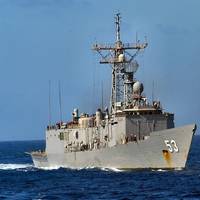
1944 - Task Force 58 begins bombing of Japanese airfields, shipping, fleet servicing facilities, and other installations at Palau, Yap, Ulithi, and Woleai in the Carolines. 1944 - USS Darter (SS 227) sinks a Japanese army cargo ship near New Guinea, despite the presence of an escort vessel. Also on this date, USS Picuda (SS 382) attacks a Japanese convoy and sinks a transport ship near Guam while USS Stingray (SS 186) sinks a transport ship near Saipan. 1953 - During the Korean War, five enemy guns in the Wonsan area fire about 20 rounds at USS Prichett (DD 561), falling about 150 yards short.
USN's 6th MCPON Passes Away
Retired Master Chief Petty Officer of the Navy (MCPON) William "Bill" H. Plackett died peacefully the evening of March 4. He was 78. Plackett became the sixth MCPON Oct. 1, 1985. He relieved Billy C. Sanders and held the job for three years before Duane R. Bushey assumed duties in September 1988. Plackett was born in Paxton, Illinois, and joined the Navy at the age of 19 in 1956. He attended radarman "A" school in Norfolk, Virginia and was assigned to the Naval Control of Shipping Office in Bahrain in the Persian Gulf. He served tours aboard Commander, Amphibious Force, U.S. Atlantic Fleet embarked upon amphibious force command ship USS Mount McKinley (AGC 7), and Commander in Chief, Allied Forces Southern Europe in Naples, Italy.
Special Pilotage in Port of Brownsville
The Brazos-Santiago Pilots handle some 600 ship and vessel transits through the Port of Brownsville each year, but it's not every day that they get the opportunity to guide a venerable and storied U.S. Navy carrier to its final destination. "It's an especially proud honor to be a part of history and to pilot the USS Ranger on the final 15-mile leg of its 16,000 nautical mile voyage to International Shipbreaking of Brownsville," said Captain Grant Wilson, the pilots' presiding officer, who along with Captain Jonathan Willett boarded the carrier. The two pilots, along with Pilot Captain Gene Tuttle, have guided three other warships -- USS Constellation…
Today in U.S. Naval History: July 30
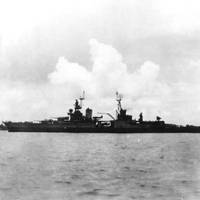
Today in U.S. 1941 - Japanese aircraft bomb USS Tutuila (PR-4) at Chungking, China; First Navy ship damaged by Axis during World War II. 1942 - Franklin D. Roosevelt signs act establishing WAVES (Women Accepted for Volunteer Emergency Service). During World War II, more than 80,000 officer and enlisted women served in the WAVES. 1944 - Naval Task Force lands Army troops near Cape Opmarai, New Guinea. 1945 - Japanese submarine, I-58, sinks USS Indianapolis (CA-35) in Philippine Sea; 316 out of 1,199 crew survived.
Today in U.S. Naval History: July 29
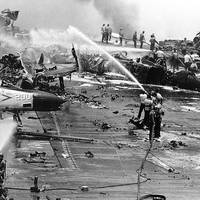
Today in U.S. Naval History - July 29 1846 - Sailors and Marines from U.S. sloop Cyane capture San Diego, Calif. 1918 - Assistant Secretary of the Navy Franklin D. Roosevelt visits Queenstown, Ireland 1945 - U.S. warships bombard Hamamatsu, Japan. 1967 - Fire on board USS Forrestal killed 134 members of the crew. For more information about naval history, visit the Naval History and Heritage Command website at history.navy.mil.
Today in U.S. Naval History: July 14
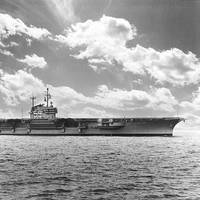
Today in U.S. 1813 - Lt. John M. 1882 - Sailors and Marines from four U.S. ships land to help restore order at Alexandria, Egypt. 1945 - U.S. warships bombard Kamaishi, Japan; first naval gunfire bombardment of Japanese Home Islands. 1950 - U.S. Marines sail from San Diego for Korean Conflict. 1952 - Laying of keel of USS Forrestal, the first 59,900 ton aircraft carrier. For more information about naval history, visit the Naval History and Heritage Command website at history.navy.mil.
US Navy Awards Contract To Dismantle Constellation
The Navy competitively awarded a contract to International Shipbreaking Limited of Brownsville, Texas, for the towing, dismantling and recycling of conventionally powered aircraft carriers stricken from service, June 13. Under the contract, the company will be paid $3 million for the dismantling and recycling of the decommissioned aircraft carrier Constellation (CV 64). The price reflects the net price proposed by International Shipbreaking, which considered the estimated proceeds from the sale of the scrap metal to be generated from dismantling. The Navy continues to own the ship during the dismantling process. The contractor takes ownership of the scrap metal as it is produced and sells the scrap to offset its costs of operations.
Today in U.S. Naval History: December 11
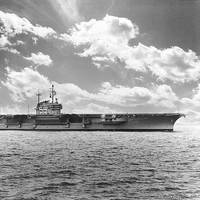
Today in U.S. Naval History - December 11 1941 - Contract establishes the Naval Salvage Service. 1941 - Wake Island Garrison under Commander Winfield Cunningham repulses Japanese invasion force. 1954 - First supercarrier of 59,630 tons, USS Forrestal (CVA-59), launched at Newport News, Va. For more information about naval history, visit the Naval History and Heritage Command website at history.navy.mil.
Navy's First Supercarrier Sold for a Penny
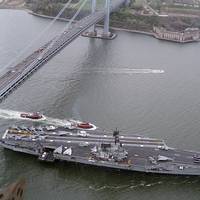
The U.S. Navy sold the 1,067-foot behemoth 'USS Forrestal' to a Texas company, All Star Metals, to be dismantled, scrapped and recycled, an inauspicious fate for a ship with a colorful and tragic history, reports Fox News, citing a Navy announcement. USS Forrestal is perhaps best known for a 1967 incident in which stray voltage triggered an accidental explosion that struck a plane on the flight deck whose cockpit was occupied by a young John McCain. A chain reaction of blasts and fires ultimately killed 134 men and injured more than 300.
Today in U.S. Naval History: October 1
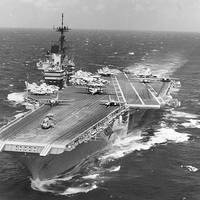
Today in U.S. 1800 - U.S. Schooner Experiment captures French Schooner Diana. 1844 - Naval Observatory headed by Lt. Matthew Fontaine Maury occupies first permanent quarters. 1874 - Supply Corps purser, Lt. J. Q. Barton, given leave to enter service of new Japanese Navy to organize a Pay Department and instruct Japanese about accounts. He served until October 1, 1877 when he again became a purser in the U.S. Navy. In 1878, the Emperor of Japan conferred on him the Fourth Class of Rising Sun for his service.
Today in U.S. Naval History: July 29

Today in U.S. Naval History - July 29 1846 - Sailors and Marines from U.S. sloop Cyane capture San Diego, Calif. 1918 - Assistant Secretary of the Navy Franklin D. Roosevelt visits Queenstown, Ireland 1945 - U.S. warships bombard Hamamatsu, Japan. 1967 - Fire on board USS Forrestal killed 134 members of the crew. For more information about naval history, visit the Naval History and Heritage Command website at history.navy.mil.
This Day in Naval History - Dec. 11
From the Navy News Service. 1941 - A contract establishes the Naval Salvage Service. 1941 - The Wake Island Garrison, under the command of Cmdr. Winfield Cunningham, turns away a Japanese invasion force. 1954 - The first supercarrier, USS Forrestal (CVA-59), launched at Newport News, Va., weighing more than 59,630 tons. For more information about Naval history, visit the Naval Historical Center Web site at www.history.navy.mil.
Soucie Takes Command of MSCEURAF
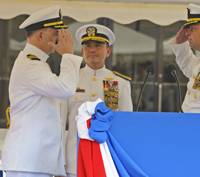
In a recent ceremony at Naval Support Activity Capodichino in Naples, Italy, Capt. Richard Soucie assumed command from Capt. James E. Tranoris of Military Sealift Command Europe and Africa (MSCEURAF), MSC’s Naples-based office. MSCEURAF is responsible for MSC ships operating in the European and African theaters and is dual-hatted as Commander, Task Force 63, coordinating and providing transportation and delivery of personnel, equipment, fuel, supplies, repair parts, mail and ammunition via air and surface logistics assets to sustain U.S. forces in the European and African theaters.
MSC Europe and Africa Changes Leadership
In a ceremony today at Naval Support Activity Capodichino in Naples, Italy, Capt. Richard Soucie assumed command from Capt. James E. Tranoris of Military Sealift Command Europe and Africa, also called MSCEURAF, MSC’s Naples-based office. MSCEURAF is responsible for MSC ships operating in the European and African theaters and is dual-hatted as Commander, Task Force 63, coordinating and providing transportation and delivery of personnel, equipment, fuel, supplies, repair parts, mail and ammunition via air and surface logistics assets to sustain U.S. forces in the European and African theaters. Soucie reports to MSCEURAF from his most recent duty as director of the Plans and Policy Division in the manpower and personnel directorate at U.S. Central Command Headquarters in Tampa, Fla.
This Day in Navy History
1813 - Lt. John Gamble, the first Marine to command a ship in battle (prize vessel Greenwich in capture of British whaler Seringapatam). 1853 - Commodore Matthew Perry lands and holds first meeting with Japanese at Uraga, Japan. 1882 - Sailors and Marines from four U.S. ships land to help restore order at Alexandria, Egypt. 1945 - U.S. warships bombard Kamaishi, Japan; first naval gunfire bombardment of Japanese Home Islands. 1950 - U.S. Marines sail from San Diego for Korean Conflict. 1952 - Laying of keel of USS Forrestal (CV 59), the first 59,900-ton aircraft carrier. For more information on naval history, visit the Naval Historical Center Web site at www.history.navy.mil.
This Day in Naval History: July 14
On July 14, 1813, LT John M. Gamble became the first marine to command a ship in battle. Forty years later, Commodore Matthew Perry held his first meeting with the Japanese in Uraga, Japan, and would go on to establish economic tries between the US and Asia. In 1882, sailors and marines from four U.S. ships landed in Alexandria, Egypt, and helped restore order. U.S. warships bombarded Kamaishi, Japan, on this day in 1945; and in 1950, U.S. marines set sail from San Diego during the Korean Conflict. Keel was laid for the first 59,900-ton aircraft carrier, the USS Forrestal, on July 14, 1952.
This Day in Naval History – October 1
1800 - U.S. Schooner Experiment captures French Schooner Diana. 1844 - Naval Observatory headed by LT Matthew Fontaine Maury occupies first permanent quarters. 1874 - Supply Corps purser, LT J. Q. Barton, given leave to enter service of new Japanese Navy to organize a Pay Department and instruct Japanese about accounts. He served until 1 October 1877 when he again became a purser in the U.S. Navy. In 1878, the Emperor of Japan conferred on him the Fourth Class of Rising Sun for his service. 1937 - Patrol aviation transferred to Aircraft Scouting Force, a reestablished type command. With change five patrol wings were established as separate administrative command over their squadrons.
This Day in Naval History – July 30
1918 - Units of First Marine Aviation Force arrive at Brest, France 1941 - Japanese aircraft bomb USS Tutuila (PR-4) at Chungking, China; First Navy ship damaged by Axis during World War II. 1942 - FDR signs act establishing WAVES (Women Accepted for Volunteer Emergency Service). During World War II, over 80,000 officer and enlisted women served in the WAVES. 1944 - Naval Task Force lands Army troops near Cape Opmarai, New Guinea. 1945 - Japanese submarine, I-58, sinks USS Indianapolis (CA-35) in Philippine Sea; 316 out of 1199 crew survived. 1967 - Fire on board USS Forrestal off the coast of Vietnam results in death of 134 crew. (Source: Navy News Service)
This Day in Naval History – July 29
1846 - Sailors and Marines from U.S. sloop Cyane capture San Diego, CA 1918 - Assistant Secretary of the Navy Franklin D. Roosevelt visits Queenstown, Ireland 1945 - U.S. warships bombard Hamamatsu, Japan. 1967 - Fire on board USS Forrestal killed 134 members of the crew. (Source: Navy News Service)







